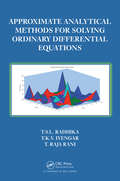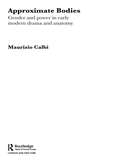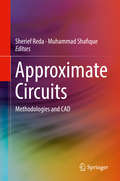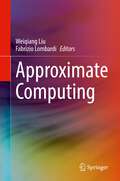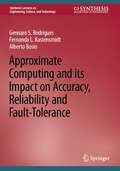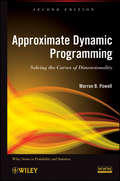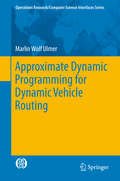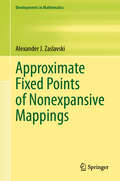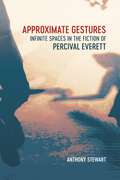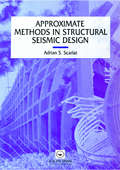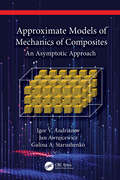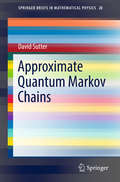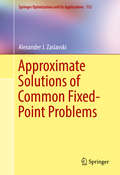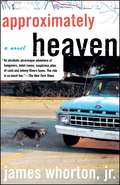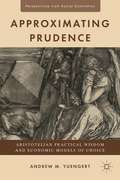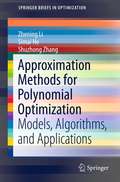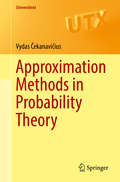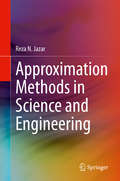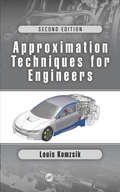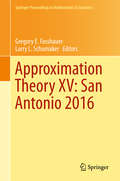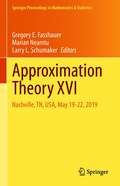- Table View
- List View
Approximate Analytical Methods for Solving Ordinary Differential Equations
by T.S.L Radhika T. Iyengar T. RaniApproximate Analytical Methods for Solving Ordinary Differential Equations (ODEs) is the first book to present all of the available approximate methods for solving ODEs, eliminating the need to wade through multiple books and articles. It covers both well-established techniques and recently developed procedures, including the classical series solut
Approximate Arithmetic Circuit Architectures for FPGA-based Systems
by Akash Kumar Salim UllahThis book presents various novel architectures for FPGA-optimized accurate and approximate operators, their detailed accuracy and performance analysis, various techniques to model the behavior of approximate operators, and thorough application-level analysis to evaluate the impact of approximations on the final output quality and performance metrics. As multiplication is one of the most commonly used and computationally expensive operations in various error-resilient applications such as digital signal and image processing and machine learning algorithms, this book particularly focuses on this operation. The book starts by elaborating on the various sources of error resilience and opportunities available for approximations on various layers of the computation stack. It then provides a detailed description of the state-of-the-art approximate computing-related works and highlights their limitations.
Approximate Bodies: Gender and Power in Early Modern Drama and Anatomy
by Maurizio CalbiThe early modern period was an age of anatomical exploration and revelation, with new discoveries capturing the imagination not only of scientists but also of playwrights and poets. Approximate Bodies examines, in fascinating detail, the changing representation of the body in early modern drama and in the period's anatomical and gynaecological treatises. Maurizio Calbi focuses on the unstable representation of both masculinity and femininity in Renaissance texts such as The Duchess of Malfi, The Changeling and a variety of Shakespeare plays. Drawing on theorists including Foucault, Derrida and Lacan, these close textual readings examine the effects of social, psychic and cultural influences on early modern images of the body. Calbi identifies the ways in which political, social, racial and sexual power structures effect the construction of the body in dramatic and anatomical texts. Calbi's analysis displays how images such as the deformed body of the outsider, the effeminate body of the desiring male and the disfigured body parts of the desiring female indicate an unstable, incomplete conception of the body in the Renaissance. Compelling and impeccably researched, this is a sophisticated account of the fantasies and anxieties that play a role in constructing the early modern body. Approximate Bodies makes a major contribution to the field of early modern studies and to debates around the body.
Approximate Circuits: Methodologies and CAD
by Muhammad Shafique Sherief RedaThis book provides readers with a comprehensive, state-of-the-art overview of approximate computing, enabling the design trade-off of accuracy for achieving better power/performance efficiencies, through the simplification of underlying computing resources. The authors describe in detail various efforts to generate approximate hardware systems, while still providing an overview of support techniques at other computing layers. The book is organized by techniques for various hardware components, from basic building blocks to general circuits and systems.
Approximate Computing
by Weiqiang Liu Fabrizio LombardiThis book explores the technological developments at various levels of abstraction, of the new paradigm of approximate computing. The authors describe in a single-source the state-of-the-art, covering the entire spectrum of research activities in approximate computing, bridging device, circuit, architecture, and system levels. Content includes tutorials, reviews and surveys of current theoretical/experimental results, design methodologies and applications developed in approximate computing for a wide scope of readership and specialists.Serves as a single-source reference to state-of-the-art of approximate computing;Covers broad range of topics, from circuits to applications;Includes contributions by leading researchers, from academia and industry.
Approximate Computing and its Impact on Accuracy, Reliability and Fault-Tolerance (Synthesis Lectures on Engineering, Science, and Technology)
by Alberto Bosio Gennaro S. Rodrigues Fernanda L. KastensmidtThis book introduces the concept of approximate computing for software and hardware designs and its impact on the reliability of embedded systems. It presents approximate computing methods and proposes approximate fault tolerance techniques applied to programmable hardware and embedded software to provide reliability at low computational costs. The book also presents fault tolerance techniques based on approximate computing, thus presenting how approximate computing can be applied to safety-critical systems.
Approximate Dynamic Programming
by Warren B. PowellPraise for the First Edition"Finally, a book devoted to dynamic programming and written using the language of operations research (OR)! This beautiful book fills a gap in the libraries of OR specialists and practitioners."--Computing ReviewsThis new edition showcases a focus on modeling and computation for complex classes of approximate dynamic programming problemsUnderstanding approximate dynamic programming (ADP) is vital in order to develop practical and high-quality solutions to complex industrial problems, particularly when those problems involve making decisions in the presence of uncertainty. Approximate Dynamic Programming, Second Edition uniquely integrates four distinct disciplines--Markov decision processes, mathematical programming, simulation, and statistics--to demonstrate how to successfully approach, model, and solve a wide range of real-life problems using ADP.The book continues to bridge the gap between computer science, simulation, and operations research and now adopts the notation and vocabulary of reinforcement learning as well as stochastic search and simulation optimization. The author outlines the essential algorithms that serve as a starting point in the design of practical solutions for real problems. The three curses of dimensionality that impact complex problems are introduced and detailed coverage of implementation challenges is provided. The Second Edition also features:A new chapter describing four fundamental classes of policies for working with diverse stochastic optimization problems: myopic policies, look-ahead policies, policy function approximations, and policies based on value function approximationsA new chapter on policy search that brings together stochastic search and simulation optimization concepts and introduces a new class of optimal learning strategiesUpdated coverage of the exploration exploitation problem in ADP, now including a recently developed method for doing active learning in the presence of a physical state, using the concept of the knowledge gradientA new sequence of chapters describing statistical methods for approximating value functions, estimating the value of a fixed policy, and value function approximation while searching for optimal policiesThe presented coverage of ADP emphasizes models and algorithms, focusing on related applications and computation while also discussing the theoretical side of the topic that explores proofs of convergence and rate of convergence. A related website features an ongoing discussion of the evolving fields of approximation dynamic programming and reinforcement learning, along with additional readings, software, and datasets.Requiring only a basic understanding of statistics and probability, Approximate Dynamic Programming, Second Edition is an excellent book for industrial engineering and operations research courses at the upper-undergraduate and graduate levels. It also serves as a valuable reference for researchers and professionals who utilize dynamic programming, stochastic programming, and control theory to solve problems in their everyday work.
Approximate Dynamic Programming for Dynamic Vehicle Routing (Operations Research/Computer Science Interfaces Series #61)
by Marlin Wolf UlmerThis book provides a straightforward overview for every researcher interested in stochastic dynamic vehicle routing problems (SDVRPs). The book is written for both the applied researcher looking for suitable solution approaches for particular problems as well as for the theoretical researcher looking for effective and efficient methods of stochastic dynamic optimization and approximate dynamic programming (ADP). To this end, the book contains two parts. In the first part, the general methodology required for modeling and approaching SDVRPs is presented. It presents adapted and new, general anticipatory methods of ADP tailored to the needs of dynamic vehicle routing. Since stochastic dynamic optimization is often complex and may not always be intuitive on first glance, the author accompanies the theoretical SDO-methodology with illustrative examples from the field of SDVRPs. The second part of this book then depicts the application of the theory to a specific SDVRP. The process starts from the real-world application. The author describes a SDVRP with stochastic customer requests often addressed in the literature, and then shows in detail how this problem can be modeled as a Markov decision process and presents several anticipatory solution approaches based on ADP. In an extensive computational study, he shows the advantages of the presented approaches compared to conventional heuristics. To allow deep insights in the functionality of ADP, he presents a comprehensive analysis of the ADP approaches.
Approximate Fixed Points of Nonexpansive Mappings (Developments in Mathematics #80)
by Alexander J. ZaslavskiFixed point theory of nonlinear operators has been a rapidly growing area of research and plays an important role in the study of variational inequalities, monotone operators, feasibility problems, and optimization theory, to name just several. This book discusses iteration processes associated with a given nonlinear mapping which generate its approximate fixed point and in some cases converge to a fixed point of the mapping. Various classes of nonlinear single-valued and set-valued mappings are considered along with iteration processes under the presence of computational errors. Of particular interest to mathematicians working in fixed point theory and nonlinear analysis, the added value for the reader are the solutions presented to a number of difficult problems in the fixed point theory which have important applications.
Approximate Gestures: Infinite Spaces in the Fiction of Percival Everett
by Anthony StewartIn Approximate Gestures, Anthony Stewart argues that the writing of Percival Everett, the acclaimed author of Erasure and more than twenty other works of fiction, compels readers to retrain their thinking habits and to value uncertainty. Stewart maintains that Everett’s fiction challenges its interpreters to question their assumptions, consider the spaces in between categories, and embrace the potential of a larger, more uncertain world in an effort to confront bigotry and similarly limiting patterns of thought. Drawing on the work of Gilles Deleuze and Félix Guattari, Stewart proposes that their notion of the schizorevolutionary figure captures the in-between status of many of Everett’s characters as they refuse the constraints of the binary, categorical structures that govern so much of human life. Approximate Gestures engages specifically with the vexed question of discussing race in Everett’s fiction. Stewart frames the stakes of analyzing such subject matter in the writing of an African American novelist whose work rigorously questions critical approaches to race. Requiring readers to engage with black males who are hydrologists, ranchers, college professors, romance novelists, and in one case, a toddler, means entering a world released from habitual frames of reference. Through an examination of a broad selection of novels, Stewart demonstrates the extent to which Everett’s characters inhabit “infinite spaces in between conventional categories” and understand themselves as subjects attempting to navigate social and psychological worlds. Approximate Gestures: Infinite Spaces in the Fiction of Percival Everett encourages readers and critics to think more deeply about how they position themselves in and engage with the world around them. As one of the first books of literary criticism devoted to Everett’s fiction, Stewart’s pathbreaking study models a method for reading the formidable body of work being produced by a major contemporary writer.
Approximate Iterative Algorithms
by Anthony Louis AlmudevarIterative algorithms often rely on approximate evaluation techniques, which may include statistical estimation, computer simulation or functional approximation. This volume presents methods for the study of approximate iterative algorithms, providing tools for the derivation of error bounds and convergence rates, and for the optimal design of such
Approximate Methods in Structural Seismic Design
by A. ScarlatThis book examines the recent developments in computerized structural analysis and finite element analysis to re-appraise existing approximate techniques and to define their scope and limits more accurately. The book proposes new techniques and provides many numerical examples and comparisons with 'accurate' methods.
Approximate Models of Mechanics of Composites: An Asymptotic Approach
by Jan Awrejcewicz Igor V. Andrianov Galina A. StarushenkoApproximate Models of Mechanics of Composites: An Asymptotic Approach is an essential guide to constructing asymptotic models and mathematical methods to correctly identify the mechanical behavior of composites. It provides methodology for predicting and evaluating composite behavior in various structures, leading to accurate mathematical and physical assessments. The book estimates the error of approximations through comparing asymptotic solutions with the results of numerical and analytical solutions to gain a holistic view of the data. The authors have developed asymptotic models based on mathematical and physical rigorous approaches, which include three-phase models of fibrous composites, a modernized three-phase composite model with cylindrical inclusions, and models of two-dimensional composites of hexagonal structure. Also covered are two-phase models of composites related to the Maxwell formula and a percolation transition model for elastic problems based on the self-consistency method and Padé approximations. By obtaining analytical expressions to effectively characterize composite materials, their physical and geometric parameters can be accurately assessed. This book suits engineers and students working in material science, mechanical engineering, physics, and mathematics, as well as composite materials in industries such as construction, transport, aerospace, and chemical engineering.
Approximate Quantum Markov Chains (SpringerBriefs In Mathematical Physics #28)
by David SutterThis book is an introduction to quantum Markov chains and explains how this concept is connected to the question of how well a lost quantum mechanical system can be recovered from a correlated subsystem. To achieve this goal, we strengthen the data-processing inequality such that it reveals a statement about the reconstruction of lost information. <P><P> The main difficulty in order to understand the behavior of quantum Markov chains arises from the fact that quantum mechanical operators do not commute in general. As a result we start by explaining two techniques of how to deal with non-commuting matrices: the spectral pinching method and complex interpolation theory. Once the reader is familiar with these techniques a novel inequality is presented that extends the celebrated Golden-Thompson inequality to arbitrarily many matrices. This inequality is the key ingredient in understanding approximate quantum Markov chains and it answers a question from matrix analysis that was open since 1973, i.e., if Lieb's triple matrix inequality can be extended to more than three matrices. Finally, we carefully discuss the properties of approximate quantum Markov chains and their implications.<P> The book is aimed to graduate students who want to learn about approximate quantum Markov chains as well as more experienced scientists who want to enter this field. Mathematical majority is necessary, but no prior knowledge of quantum mechanics is required.
Approximate Solutions of Common Fixed-Point Problems (Springer Optimization and Its Applications #112)
by Alexander J. ZaslavskiThis book presents results on theconvergence behavior of algorithms which are known as vital tools for solvingconvex feasibility problems and common fixed point problems. The main goal forus in dealing with a known computational error is to find what approximatesolution can be obtained and how many iterates one needs to find it. Accordingto know results, these algorithms should converge to a solution. In thisexposition, these algorithms are studied, taking into account computationalerrors which remain consistent in practice. In this case the convergence to asolution does not take place. We show that our algorithms generate a goodapproximate solution if computational errors are bounded from above by a smallpositive constant. Beginning with an introduction, this monograph moves onto study: · dynamicstring-averaging methods for common fixed point problems in a Hilbert space · dynamicstring methods for common fixed point problems in a metric space · dynamicstring-averaging version of the proximal algorithm · common fixedpoint problems in metric spaces · common fixedpoint problems in the spaces with distances of the Bregman type · a proximalalgorithm for finding a common zero of a family of maximal monotone operators · subgradientprojections algorithms for convex feasibility problems in Hilbert spaces
Approximately Heaven
by James Whorton Jr.Enter the distinctly off-kilter world of Don "Wendell" Brush, an unemployed Tennessee electrician with a penchant for throwing back a few beers before lunch. Mary, his long-suffering wife of seven years, has left him -- or is trying to. Heartsick at the thought of losing her, Don beats her out the door, reasoning that if he leaves, Mary will have to stay behind in their ramshackle house to take care of their dog and cat. On the strength of this logic, Don finds himself out on the street with only his decrepit old truck, the shirt on his back, and nothing to do but avoid home. Approximately Heaven is a marvelously rambunctious debut, by turns melancholy and uproarious, about one hapless man's pursuit of happiness -- or at least another six-pack -- preferably both. The novel charts Don's amiably clumsy attempts to improve his situation, beginning with his decision to take a road trip with his friend Dove Ellender -- a retired, chain-drinking ex-felon with emphysema -- to Mississippi to deliver some furniture. Or maybe there's something besides furniture in the trailer behind Dove's leaky half-ton green-and-white 1969 Ford truck, but Don isn't asking and Dove's not telling. Will Don find his heaven -- or something close to it? Will Mary give him another chance (his fourth, actually)? If heaven is a house that is square, level, and plumb -- with a loving family inside -- then for Don, even a sober hope of these things would be enoughIn the course of his hero's grand misadventures, prizewinning short-story writer James Whorton traverses the broken white line between the absurd and the desperately poignant. Fans of Richard Russo will want to raise a glass -- or at least crack open a can of Natural Light. Featuring an endearingly flawed protagonist, dead-perfect dialogue, and a mordant eye for small-town southern life, Approximately Heaven is about the paradise we long for and the approximations for which we settle. It heralds the arrival of a major -- and heaven-sent -- new literary talent.
Approximating Perfection
by Leonid P. Lebedev Michael J. CloudThis is a book for those who enjoy thinking about how and why Nature can be described using mathematical tools. Approximating Perfection considers the background behind mechanics as well as the mathematical ideas that play key roles in mechanical applications. Concentrating on the models of applied mechanics, the book engages the reader in the types of nuts-and-bolts considerations that are normally avoided in formal engineering courses: how and why models remain imperfect, and the factors that motivated their development. The opening chapter reviews and reconsiders the basics of calculus from a fully applied point of view; subsequent chapters explore selected topics from solid mechanics, hydrodynamics, and the natural sciences. Emphasis is placed on the logic that underlies modeling in mechanics and the many surprising parallels that exist between seemingly diverse areas. The mathematical demands on the reader are kept to a minimum, so the book will appeal to a wide technical audience.
Approximating Prudence
by Andrew M. YuengertIn a unique undertaking, Andrew Yuengert explores and describes the limits to the economic model of the human being, providing an alternative account of human choice, to which economic models can be compared.
Approximation Methods for Polynomial Optimization: Models, Algorithms, and Applications (SpringerBriefs in Optimization)
by Zhening Li Simai He Shuzhong ZhangPolynomial optimization have been a hot research topic for the past few years and its applications range from Operations Research, biomedical engineering, investment science, to quantum mechanics, linear algebra, and signal processing, among many others. In this brief the authors discuss some important subclasses of polynomial optimization models arising from various applications, with a focus on approximations algorithms with guaranteed worst case performance analysis. The brief presents a clear view of the basic ideas underlying the design of such algorithms and the benefits are highlighted by illustrative examples showing the possible applications. This timely treatise will appeal to researchers and graduate students in the fields of optimization, computational mathematics, Operations Research, industrial engineering, and computer science.
Approximation Methods in Probability Theory (Universitext)
by Vydas ČekanavičiusThis book presents a wide range of well-known and less common methods used for estimating the accuracy of probabilistic approximations, including the Esseen type inversion formulas, the Stein method as well as the methods of convolutions and triangle function. Emphasising the correct usage of the methods presented, each step required for the proofs is examined in detail. As a result, this textbook provides valuable tools for proving approximation theorems. While Approximation Methods in Probability Theory will appeal to everyone interested in limit theorems of probability theory, the book is particularly aimed at graduate students who have completed a standard intermediate course in probability theory. Furthermore, experienced researchers wanting to enlarge their toolkit will also find this book useful.
Approximation Methods in Science and Engineering
by Reza N. JazarApproximation Methods in Engineering and Science covers fundamental and advanced topics in three areas: Dimensional Analysis, Continued Fractions, and Stability Analysis of the Mathieu Differential Equation. Throughout the book, a strong emphasis is given to concepts and methods used in everyday calculations. Dimensional analysis is a crucial need for every engineer and scientist to be able to do experiments on scaled models and use the results in real world applications. Knowing that most nonlinear equations have no analytic solution, the power series solution is assumed to be the first approach to derive an approximate solution. However, this book will show the advantages of continued fractions and provides a systematic method to develop better approximate solutions in continued fractions. It also shows the importance of determining stability chart of the Mathieu equation and reviews and compares several approximate methods for that. The book provides the energy-rate method to study the stability of parametric differential equations that generates much better approximate solutions.
Approximation Techniques for Engineers: Second Edition
by Louis KomzsikThis second edition includes eleven new sections based on the approximation of matrix functions, deflating the solution space and improving the accuracy of approximate solutions, iterative solution of initial value problems of systems of ordinary differential equations, and the method of trial functions for boundary value problems. The topics of th
Approximation Theory XIV: San Antonio 2013 (Springer Proceedings in Mathematics & Statistics #83)
by Gregory E. Fasshauer Larry L. SchumakerThese proceedings were prepared in connection with the 14th International Conference on Approximation Theory, which was held April 7-10, 2013 in San Antonio, Texas. The conference was the fourteenth in a series of meetings in Approximation Theory held at various locations in the United States. The included invited and contributed papers cover diverse areas of approximation theory with a special emphasis on the most current and active areas such as compressed sensing, isogeometric analysis, anisotropic spaces, radial basis functions and splines. Classical and abstract approximation is also included The book will be of interest to mathematicians, engineers\ and computer scientists working in approximation theory, computer-aided geometric design, numerical analysis and related application areas.
Approximation Theory XV: San Antonio 2016 (Springer Proceedings in Mathematics & Statistics #201)
by Gregory E. Fasshauer Larry L. SchumakerThese proceedings are based on papers presented at the international conference Approximation Theory XV, which was held May 22-25, 2016 in San Antonio, Texas. The conference was the fifteenth in a series of meetings in Approximation Theory held at various locations in the United States, and was attended by 146 participants. The book contains longer survey papers by some of the invited speakers covering topics such as compressive sensing, isogeometric analysis, and scaling limits of polynomials and entire functions of exponential type. The book also includes papers on a variety of current topics in Approximation Theory drawn from areas such as advances in kernel approximation with applications, approximation theory and algebraic geometry, multivariate splines for applications, practical function approximation, approximation of PDEs, wavelets and framelets with applications, approximation theory in signal processing, compressive sensing, rational interpolation, spline approximation in isogeometric analysis, approximation of fractional differential equations, numerical integration formulas, and trigonometric polynomial approximation.
Approximation Theory XVI: Nashville, TN, USA, May 19-22, 2019 (Springer Proceedings in Mathematics & Statistics #336)
by Gregory E. Fasshauer Larry L. Schumaker Marian NeamtuThese proceedings are based on the international conference Approximation Theory XVI held on May 19–22, 2019 in Nashville, Tennessee. The conference was the sixteenth in a series of meetings in Approximation Theory held at various locations in the United States. Over 130 mathematicians from 20 countries attended. The book contains two longer survey papers on nonstationary subdivision and Prony’s method, along with 11 research papers on a variety of topics in approximation theory, including Balian-Low theorems, butterfly spline interpolation, cubature rules, Hankel and Toeplitz matrices, phase retrieval, positive definite kernels, quasi-interpolation operators, stochastic collocation, the gradient conjecture, time-variant systems, and trivariate finite elements. The book should be of interest to mathematicians, engineers, and computer scientists working in approximation theory, computer-aided geometric design, numerical analysis, and related approximation areas.
